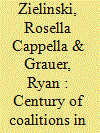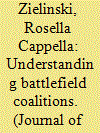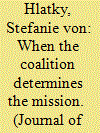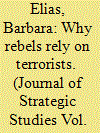|
|
|
Sort Order |
|
|
|
Items / Page
|
|
|
|
|
|
|
| Srl | Item |
| 1 |
ID:
186090


|
|
|
|
|
| Summary/Abstract |
Under what conditions do battlefield coalitions fight as greater or less than the sum of their parts? Introducing the Belligerents in Battle dataset, which contains information on actors fighting in 492 battles during interstate wars waged between 1900 and 2003, we present, for the first time, a portrait of the universe of battlefield coalitions. Battlefield coalitions win more often and suffer fewer casualties than belligerents fighting alone. Battlefield coalitions including forces fielded by the United States, states with pre-existing treaty agreements, and democracies are particularly powerful. By contrast, battlefield coalitions that include non-state actors lose the majority of their fights.
|
|
|
|
|
|
|
|
|
|
|
|
|
|
|
|
| 2 |
ID:
186089


|
|
|
|
|
| Summary/Abstract |
Battlefield coalitions are distinct warfighting collectives. They are the groups of forces created by states that are formal allies, states that have no written agreement to cooperate militarily, non-state actors, or some combination thereof to engage in combat at the operational and tactical levels of war. They are also increasingly common belligerents in war, but there is little scholarship on their creation, composition, operation, and achievements. This special issue begins the necessary work of improving our understanding of battlefield coalitions, providing new insight into their nature and capabilities, as well as the military and political consequences of their combat operations.
|
|
|
|
|
|
|
|
|
|
|
|
|
|
|
|
| 3 |
ID:
186093


|
|
|
|
|
| Summary/Abstract |
In this article, we argue that the composition of coalitions is key to understanding military operations, because it encompasses decisive intra-coalition dynamics such as great power and alliance politics, caveats and institutional constraints. The case study analysis, focused on NATO’s war in Libya, relies on content analysis of national and NATO policy documents as well as interviews with policymakers and military officials. We find that, while great powers predictably shape how missions are designed and carried out, their precise influence is affected by factors that are inherent to a coalition’s composition.
|
|
|
|
|
|
|
|
|
|
|
|
|
|
|
|
| 4 |
ID:
186092


|
|
|
|
|
| Summary/Abstract |
Why do some rebels form persistent battlefield coalitions with terrorist groups? I argue three factors are likely to condition whether the benefits of doing so outweigh the costs: 1) potential rivalry among coalition members’ political agendas, 2) the military, organizational, and political value terrorists can bring to the collective, and 3) the degree to which local partnerships are institutionalized or reinforced through threats of intra-coalitional violence. Analyzing previously classified and captured primary source documents, I examine the Taliban’s persistence in forming battlefield coalitions with al-Qaeda in Afghanistan (1979 – present) and find significant empirical support for the argument.
|
|
|
|
|
|
|
|
|
|
|
|
|
|
|
|
|
|
|
|
|